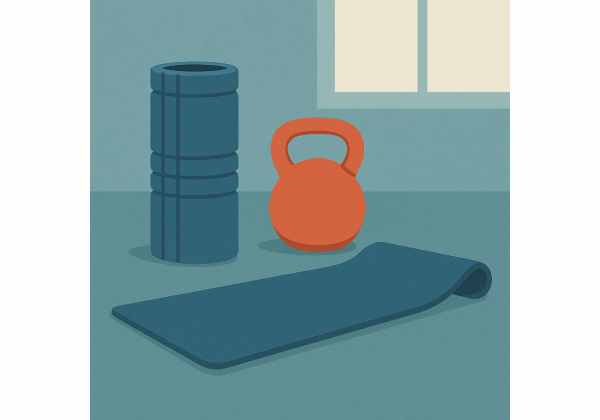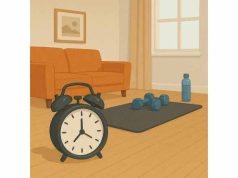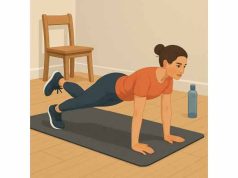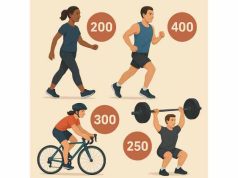
A good plan is more than workouts. The right warm-up gets you moving well in minutes, mobility keeps joints happy, and recovery lets you show up tomorrow. When you train in a calorie deficit, these pieces matter even more: tissues repair slower, and motivation rises and falls with soreness and sleep. This guide gives you a fast, repeatable warm-up, mobility that actually improves performance, and simple recovery rules you can keep during busy weeks. We’ll also show how to adjust when something aches and how to schedule rest without losing momentum. For the broader picture—how strength, cardio, and steps fit together—see our exercise framework for weight loss.
Table of Contents
- Why warm-ups and recovery matter
- 5-minute warm-up template
- Mobility that actually helps
- Between-workout recovery
- Soreness, pain, and red flags
- Recovery for cardio vs lifting
- Sleep, stress, and nutrition basics
- Frequently Asked Questions
Why warm-ups and recovery matter
Warm-ups, mobility, and recovery aren’t add-ons—they are how you turn “workouts” into progress. In a calorie deficit, your body conserves resources. Prepared tissues and smart recovery lower the repair bill so you can keep training, keep steps high, and keep the deficit modest.
Warm-ups raise performance right now.
A brisk temperature bump and rehearsal of key positions improve muscle force output and joint range in minutes. You move more efficiently, need fewer “feel” sets, and reduce wobbly reps that irritate tissues. Done well, a warm-up is short and specific: raise heat, groove patterns, then lift or do cardio.
Mobility buys you options.
You do not need to be hypermobile; you need enough range to hit safe positions under light load and enough control to keep those positions under fatigue. Targeted mobility for ankles, hips, and the upper back (T-spine) solves most common bottlenecks—deep squats, smooth running stride, overhead presses that don’t crank the low back.
Recovery makes consistency possible.
Training quality lives or dies on sleep, daily movement (NEAT), and food timing. You adapt to what you can recover from, not what you survive. In practical terms: keep most days easy-to-moderate, anchor two short strength sessions per week, and manage soreness so steps don’t crash.
The weight-loss connection.
Sore people move less outside workouts and snack more. A plan that keeps soreness predictable protects your step count and appetite signals. That’s the quiet advantage of good prep and recovery—it supports both energy out and adherence.
New to training or returning after time off? Review our concise overview of safe rate of change and habit building in sustainable weight-loss basics before ramping up.
5-minute warm-up template
You don’t need elaborate routines. You need a fast sequence you’ll repeat—one that raises heat, checks joints, and rehearses the movements you’re about to do. Use the base version on busy days and the expanded version when energy is high.
The 5-Minute Base (works for lifting or cardio)
- Easy pulse (60–90 s): Brisk walk, light bike, or march in place.
- Big joints (60–90 s):
- Ankle rocks (10/side)
- Hip openers (“gate” in/out, 5/side)
- T-spine rotations (5/side)
- Pattern primers (90–120 s): Pick 2 that match the day
- Hinge: Hip hinge to wall × 10
- Squat: Sit-to-stand × 10
- Push: Elevated push-ups × 6–8
- Pull: Band row × 12
- Gait: High-knee march + heel-to-toe roll × 10/side
- Rehearsal set (30–60 s): First exercise at ~50% load/speed, crisp technique.
8–10 Minute Expanded Option
- Add calf raises (12–15), glute bridges (10), and dead bugs (6–8/side).
- For running/walking days: 2 × 20-second strides (quick steps, not sprints) with full recovery.
- For overhead days: Wall slides (8–10) and scapular push-ups (8–10).
Speed vs thoroughness rule
If time is tight, keep the order (heat → joints → pattern → rehearsal) and trim reps, not entire phases. Consistency beats a “perfect” 20-minute routine done once a week.
Exercise-specific add-ons
- Heavy squats/hinges: Two ramp-up sets (5 reps at ~60%, then 3 reps at ~75%).
- Pressing days: Add 1–2 sets of light band pull-aparts (12–15) to balance the shoulder.
- Intervals on bike/rower: Start with 4 minutes easy, then 3 × 20 s fast / 40 s easy.
Common mistakes
- Static stretching cold. Long static holds are fine after training or away from sessions; before lifting, they can blunt immediate force.
- Skipping pattern rehearsal. Heat alone isn’t enough—groove the motion you’re about to load.
- Adding novelty weekly. Familiar warm-ups are faster and more effective.
If you’re pairing this with a simple lifting split, borrow exercises from our beginner strength plan so the warm-up flows directly into the first sets.
Mobility that actually helps
Mobility pays off when it improves a specific task: deeper, pain-free squats; easier overhead reach; smoother stride. Random stretching feels productive but delivers less than targeted work plus strength in that new range.
Prioritize three hubs
- Ankles: Dorsiflexion (knee-over-toe) allows upright squats and shock absorption during walking/running.
- Drills: Knee-to-wall rocks (3 × 10/side); calf eccentrics (3 × 8 slow).
- Test: Can your knee touch the wall while heel stays down at a fist’s distance?
- Hips: Rotation and flexion make split squats comfortable and reduce low-back compensation.
- Drills: 90/90 switches (2 × 8/side), elevated lunge rock-backs (2 × 8/side).
- Strength link: Split squat through the now-available range (2–3 × 8).
- T-spine/shoulders: Upper-back rotation and scap control enable pressing without cranky necks.
- Drills: Open-book (2 × 6/side), side-lying windmills (2 × 6/side), wall slides (2 × 10).
- Strength link: Row variations (2–3 × 10) to “own” the position.
10-Minute Mobility Circuits (pick 1)
- Lower-body day: Knee-to-wall, 90/90, glute bridge iso holds; repeat twice.
- Upper-body day: Windmills, wall slides, band face pulls; repeat twice.
- Cardio day: Ankle rocks, marching A-steps, calf eccentrics; finish with 2 easy strides.
When to use static stretching
- Post-session or evening, 30–60 s holds × 2–3 for tight areas.
- Useful for calves, hip flexors, pecs. Follow with light strength the next day to keep range.
“Mobility minimum viable dose”
- 8–12 focused minutes on training days, plus a 5-minute “reset” on long desk days: get up hourly, do 10 ankle rocks, 10 chair hip hinges, 10 band pull-aparts.
Progress you can measure
- Retest range (e.g., knee-to-wall distance) monthly.
- Track how many warm-up sets it takes to feel “ready”—that number should drop.
If you enjoy mindful movement and want a session that doubles as mobility and light conditioning, occasional gentle flow sessions can complement these drills—aim for short, consistent practices rather than long, rare ones.
Between-workout recovery
Recovery isn’t a spa day; it’s inputs you can control that make tomorrow’s training better. Focus on the big rocks first.
Sleep (the highest-leverage tool)
- Target 7–9 hours. Keep a consistent wind-down, cool room, and dark environment.
- If nights run short, add a 20–30 minute early-afternoon nap (not after 4 p.m.).
Steps and light movement
- On rest or light days, keep 7,000–10,000 steps to maintain circulation and appetite control.
- Short walks after meals (10–15 minutes) improve blood sugar and reduce heaviness before evening workouts.
Hydration and electrolytes
- Start the day with water; add sodium if you train hot or sweat heavily.
- During longer cardio (>45 minutes), a light electrolyte drink can help you maintain output and feel.
Self-care that works
- Foam rolling: 1–2 minutes per tight area, slow and relaxed, then move the joint actively.
- Heat or shower: Use before mobility to nudge range; use ice only for acute injuries.
Weekly rhythm
- Stack harder days next to each other sparingly; follow with a true easy day.
- Every 3–4 weeks, take a lighter week: reduce volume by ~20–30% while keeping movement quality.
Not sure how many easy days you need? Our overview of rest day planning explains how to balance stress, soreness, and progress signs.
Soreness, pain, and red flags
Some soreness is normal. Pain that changes your movement or lingers into daily life is a different story. Use this decision tree to stay safe and keep momentum.
DOMS (delayed soreness) basics
- Peaks 24–48 hours after unfamiliar or high-eccentric work (e.g., RDLs, downhill).
- Move, hydrate, and keep sessions easy until it fades. Gentle cardio accelerates recovery.
Modify the next session if:
- Soreness limits range or speed in your warm-up.
- A joint feels sharp or pinpoint with specific moves.
- Your gait or lifting technique changes to avoid discomfort.
Practical downgrades
- Swap barbell moves for dumbbell/machine patterns that feel stable.
- Reduce range slightly (e.g., box squat) and rebuild depth over 1–2 weeks.
- Keep intensity moderate: stop sets with 1–3 reps in reserve.
Stop and seek care if:
- Pain worsens during the session; swelling or warmth appears; pain wakes you at night.
- Numbness/tingling or giving-way sensations occur.
Common hotspots + tweaks
- Shins/Achilles: Cut steep hills; shorten stride; increase cadence; add calf eccentrics.
- Knees: Sit back more on squats; strengthen hips; avoid deep fatigue on step-downs early on.
- Low back: Own the brace; hinge from hips; avoid breath-held grinding when tired.
Need lower-impact options while things calm down? Try the adjustments in our guide to joint-friendly cardio options.
Recovery for cardio vs lifting
Cardio and strength create different kinds of fatigue. Matching recovery to the stressor speeds adaptation and reduces plateaus.
Zone 2 / steady cardio
- Low-to-moderate stress on tissues; repeatable daily if volume is sensible.
- Recovery focus: steps, light mobility, hydration, and occasional strides to keep mechanics crisp.
Intervals / hills / sprints
- High nervous-system and local muscle stress; expect 48 hours to feel fully fresh if you’re new.
- Keep hard days 1–2×/week; place easy movement or upper-body strength the day after.
- Fuel before (carbs) and after (protein + carbs) to avoid “empty-tank” sessions.
Strength training
- Micro-damage in trained muscles; soreness doesn’t equal progress, but it often follows new patterns.
- Recover with sleep, protein, and light circulation work (walking, easy cycling).
- Avoid stacking heavy lower-body training with steep hill intervals on the same day.
A sample week that respects recovery
- Mon: Strength A (squat focus) + easy walk
- Tue: Zone 2 cardio 30–40 min
- Wed: Strength B (hinge/push/pull)
- Thu: Intervals or hills (short, quality)
- Fri: Mobility + easy walk
- Sat: Longer Zone 2 or hike
- Sun: Rest
Curious when to choose intervals versus longer easy work? See our comparison of intervals vs steady work for fat loss and adherence.
Sleep, stress, and nutrition basics
You adapt from inputs, not intentions. Nail these basics to keep training productive while losing weight.
Protein and timing
- Aim for 1.6–2.2 g/kg body weight/day, split across 2–4 meals.
- Include 20–40 g protein within a few hours after training to support repair.
- Pair with carbs around harder sessions for performance and mood.
Calories and deficit
- Use a modest deficit (~300–500 kcal/day). Larger cuts increase fatigue, hunger, and injury risk.
- Keep 80–90% of meals repeatable (same foods, easy portions). Save novelty for the remaining 10–20%.
Micronutrients, fiber, and fluids
- Center meals on produce, legumes, whole grains, lean proteins, and dairy/fortified alternatives.
- Hydrate steadily; add sodium if you train hot or sweat heavily.
Sleep execution
- Same bedtime/wake time all week.
- Dim lights 60–90 minutes before bed; short, relaxing routine beats doom-scrolling.
- If nights are chaotic, protect sleep opportunity first; perfection is optional.
Stress and the nervous system
- Short breathing practice (4–6 slow breaths) after sessions shifts you into recovery mode.
- Micro-walks (5–10 minutes) between meetings manage both stress and step count.
Supplements (optional, not required)
- Creatine monohydrate (3–5 g/day): Supports strength and training quality; safe for most.
- Caffeine (1–3 mg/kg): Can improve effort; avoid late-day use if it harms sleep.
Frequently Asked Questions
How long should a warm-up take?
Five minutes works on busy days; ten is plenty for most sessions. Follow the sequence: raise heat, move big joints, rehearse the pattern, then do a light rehearsal set. If you need more time to feel ready, add one extra ramp-up set, not random drills.
Should I static stretch before lifting or running?
Do static stretches after training or away from workouts. Before sessions, use dynamic movements and position-specific drills. Static holds can momentarily reduce force output; they’re better for long-term flexibility when followed by light strength through the new range.
Does foam rolling really help recovery?
Foam rolling feels good and may reduce transient tightness when followed by active movement. Keep it brief—1–2 minutes per area—then move the joint (e.g., ankle rocks after calf rolling). It’s an accessory, not a substitute for sleep, steps, and smart loading.
How often should I do mobility work?
8–12 focused minutes on training days is enough for most people. Add a quick five-minute “desk reset” on long sitting days. Choose drills that target your bottlenecks (ankles, hips, T-spine) and pair gains in range with light strength to keep them.
What are signs I need a deload?
You’re grinding through warm-ups, sleep is poor, soreness lingers past 48 hours, and easy paces feel hard. Take a lighter week: cut volume by ~20–30%, keep technique sharp, and maintain steps. Resume progression when energy and sleep normalize.
How do I warm up if I only walk for exercise?
Start with 2–3 minutes easy, then add 30–60 seconds of quicker steps or a modest incline. Include ankle rocks and a few calf raises before stepping on the belt. Keep posture tall and stride slightly shorter on hills to protect shins and Achilles.
Can recovery work replace a workout on busy weeks?
If time is tight, do a micro-session: five-minute warm-up, one or two compound lifts for two sets each, then a 10-minute brisk walk. It’s better than skipping and keeps the habit intact. Save longer mobility or stretching for the evening.
References
- Acute Effects of Static Stretching on Muscle Strength and Power: An Attempt to Clarify Previous Caveats 2019 (Systematic Review)
- Systematic review and meta-analysis of protein intake to support muscle mass and function in healthy adults 2022 (Systematic Review & Meta-analysis)
- International society of sports nutrition position stand: caffeine and exercise performance 2021 (Guideline/Position Statement)
- International Society of Sports Nutrition position stand: safety and efficacy of creatine supplementation in exercise, sport, and medicine 2017 (Guideline/Position Statement)
- After Dinner Rest a While, After Supper Walk a Mile? A Systematic Review with Meta-analysis on the Acute Postprandial Glycemic Response to Exercise Before and After Meal Ingestion in Healthy Subjects and Patients with Impaired Glucose Tolerance 2023 (Systematic Review & Meta-analysis)
Disclaimer
This content is educational and not a substitute for personalized medical advice. Consult a qualified health professional before starting or modifying an exercise or nutrition program—especially if you have cardiovascular, metabolic, or orthopedic conditions, are pregnant, or are returning from injury or surgery.
If this guide helped you, please share it with a friend. You’re welcome to follow us on Facebook or X for practical training templates and steady, evidence-informed updates.










